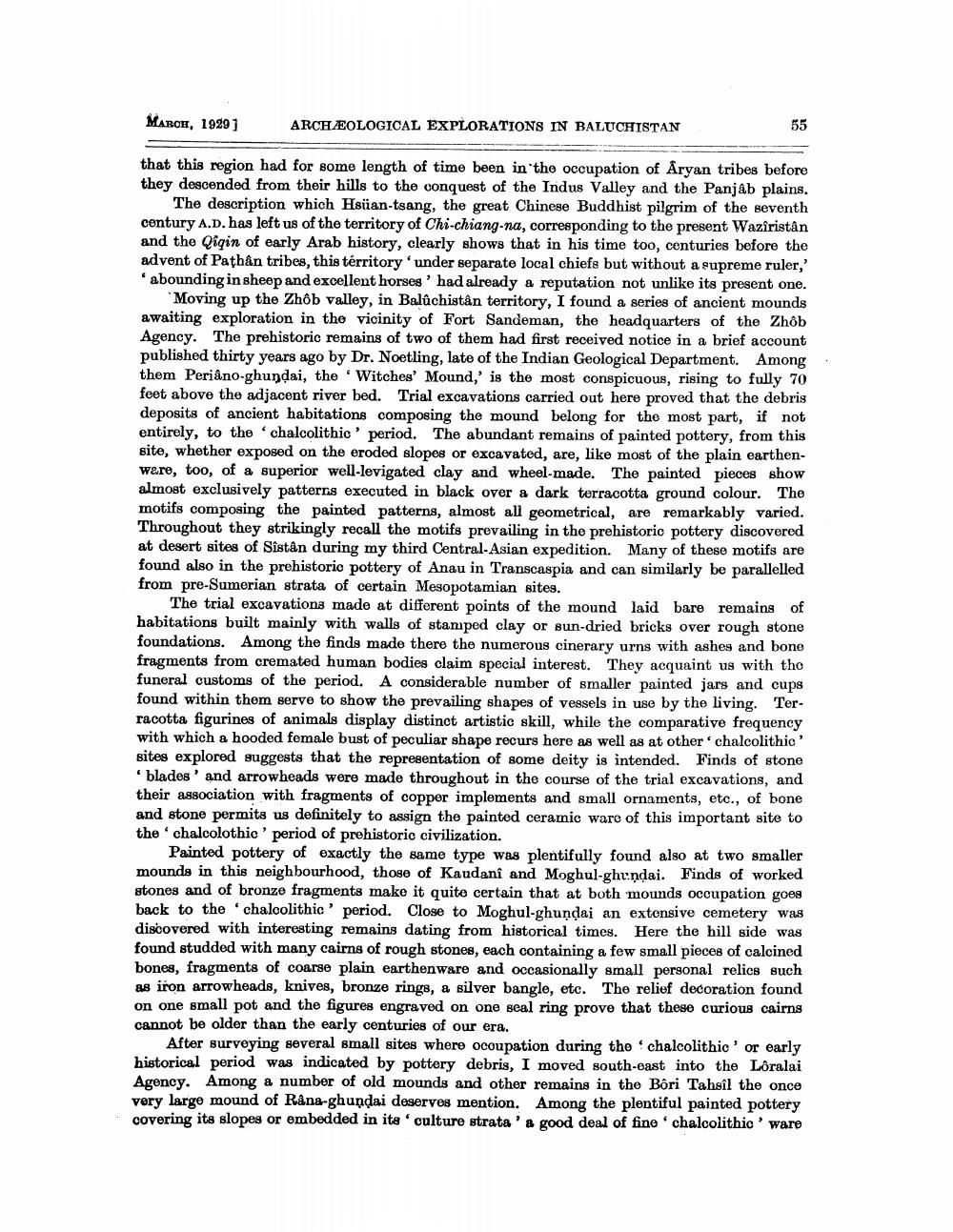________________
MAROH, 1929]
ARCHÆOLOGICAL EXPLORATIONS IN BALUCHISTAN
that this region had for some length of time been in the occupation of Aryan tribes before they descended from their hills to the conquest of the Indus Valley and the Panjab plains.
The description which Hsüan-tsang, the great Chinese Buddhist pilgrim of the seventh century A.D. has left us of the territory of Chi-chiang-na, corresponding to the present Waziristân and the Qigin of early Arab history, clearly shows that in his time too, centuries before the advent of Pathân tribes, this territory 'under separate local chiefs but without a supreme ruler,' abounding in sheep and excellent horses' had already a reputation not unlike its present one.
"Moving up the Zhob valley, in Balûchistân territory, I found a series of ancient mounds awaiting exploration in the vicinity of Fort Sandeman, the headquarters of the Zhôb Agency. The prehistoric remains of two of them had first received notice in a brief account published thirty years ago by Dr. Noetling, late of the Indian Geological Department. Among them Periâno-ghundai, the Witches' Mound,' is the most conspicuous, rising to fully 70 feet above the adjacent river bed. Trial excavations carried out here proved that the debris deposits of ancient habitations composing the mound belong for the most part, if not entirely, to the chalcolithic' period. The abundant remains of painted pottery, from this site, whether exposed on the eroded slopes or excavated, are, like most of the plain earthenware, too, of a superior well-levigated clay and wheel-made. The painted pieces show almost exclusively patterns executed in black over a dark terracotta ground colour. The motifs composing the painted patterns, almost all geometrical, are remarkably varied. Throughout they strikingly recall the motifs prevailing in the prehistoric pottery discovered at desert sites of Sistán during my third Central-Asian expedition. Many of these motifs are found also in the prehistoric pottery of Anau in Transcaspia and can similarly be parallelled from pre-Sumerian strata of certain Mesopotamian sites.
The trial excavations made at different points of the mound laid bare remains of habitations built mainly with walls of stamped clay or sun-dried bricks over rough stone foundations. Among the finds made there the numerous cinerary urns with ashes and bone fragments from cremated human bodies claim special interest. They acquaint us with the funeral customs of the period. A considerable number of smaller painted jars and cups found within them serve to show the prevailing shapes of vessels in use by the living. Terracotta figurines of animals display distinct artistic skill, while the comparative frequency with which a hooded female bust of peculiar shape recurs here as well as at other chalcolithio' sites explored suggests that the representation of some deity is intended. Finds of stone
blades' and arrowheads were made throughout in the course of the trial excavations, and their association with fragments of copper implements and small ornaments, etc., of bone and stone permits us definitely to assign the painted ceramic ware of this important site to the chalcolothio' period of prehistorio civilization.
Painted pottery of exactly the same type was plentifully found also at two smaller mounds in this neighbourhood, those of Kaudani and Moghul-ghundai. Finds of worked stones and of bronze fragments make it quite certain that at both mounds occupation goes back to the chalcolithic' period. Close to Moghul-ghundai an extensive cemetery was discovered with interesting remains dating from historical times. Here the hill side was found studded with many cairns of rough stones, each containing a few small pieces of calcined bones, fragments of coarse plain earthenware and occasionally small personal relics such as iron arrowheads, knives, bronze rings, a silver bangle, etc. The relief decoration found on one small pot and the figures engraved on one seal ring prove that these curious cairns cannot be older than the early centuries of our era.
After surveying several small sites where ocoupation during the chalcolithic' or early historical period was indicated by pottery debris, I moved south-east into the Lôralai Agency. Among a number of old mounds and other remains in the Bôri Tahsil the once very large mound of Rana-ghundai deserves mention. Among the plentiful painted pottery covering its slopes or embedded in its culture strata' good deal of fine chalcolithic' ware




